Recent
- Lisa Kusel

- Aug 3, 2022

I. TACKING One of the fitness chicks I follow is Tracy Steen. She’s a strong smart woman in her 50s who posts workouts and interviews and lectures, all geared toward helping folks get healthier. Over the years, she and I have gotten to know one another a bit, at least virtually. Our daughters are the same age. Last year I introduced her to a friend who wrote a book about her eating disorder, and Tracy hosted her on one of her live feeds. Anyway, this past February, Tracy packed up all her weights and fitness gear and relocated to St. Thomas for two months. She wanted to get away from the harsh British Columbia winters and film her workouts with the ocean as her backdrop, instead of her basement wall. She also went, she admitted with nervous honesty, that she’d never traveled or lived alone and was anxious to give it a go. Every day I checked her new workout uploads, admiring her ability to exercise so strenuously in such heat and humidity. (If you are at all acquainted with me, you know I can hardly brush my teeth in hot and sticky environs.)

I tried following along on a couple of the workouts, but watching Tracy having to constantly move her yoga mat out of the rain or skirting the ever-present reptiles and insects scurrying about, made my muscles tense up. Sure, that brilliant blue ocean behind her was picturesque enough, but, darn, I missed her cool clean basement gym.
On Instagram, Tracy posted stories of her taking walks along the beach, going into town, cooking delicious meals. In most of them she was, as she’d planned to be, alone. It was obvious she was fine; content even, but I silently wondered if maybe she wanted to be more social. Perhaps make a new friend or two.
II. FIRST MATE
I attended Sonoma State University back when it was a small laid-back hippie college surrounded by wild mustard fields. Its dorms were famous for being named after grape varieties (I lived in Chardonnay) and you could minor in enology. The cafeteria served vegan meals before it was even a thing. And, if you wanted to lounge topless by the pool or eat magic mushrooms and dance around the duck pond, no one took much notice.
During my sophomore year I met Douglas, a tow-haired southern California beach babe who lived for adventure. Up until the first time he kissed me, I’d spent most of my days hanging out in dark spaces writing sulky poetry. Douglas hauled me out of my dorm room and into the wilderness. We hiked every Sonoma County park; backpacked throughout the Sierras; and during our first summer together, we road-tripped the entire California coast. When he joined the sailing team, he pushed me to sign on too.
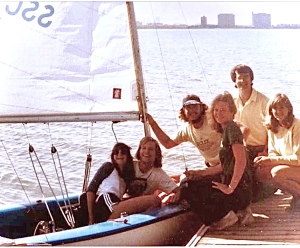
At first, I was a complete and utter klutz on the Flying Junior sailboat we raced. I tripped on ropes. Fell overboard often. And my wind-reading skills were laughably nonexistent. With Doug’s help, I was soon jibing like a well-practiced amateur: ducking under the boom without getting a concussion; quickly tugging the ropes taut and hiking my tiny frame out over the sea, my long dark hair skimming the sea’s surface as we flew through the salty air. Fast tacking and fierce determination aside, we never ever won a regatta. Our old boat

wasn’t as efficient as the fancier, newer boats the teams from Stanford and the UC schools raced. While we competed in cut-offs and bathing suits, the other teams wore uniforms. To be sure, we were a ragtag club, but we had a lot of fun.
Our losing streak came to an abrupt end when Peter HolmbergPeter Holmberg transferred over from a junior college. A white guy with sandy-colored dreadlocks who wore a grommet as an earring, Peter’s parents had honeymooned on St. Thomas, and never left. Peter learned to sail when he was six. He lived and breathed sailing.
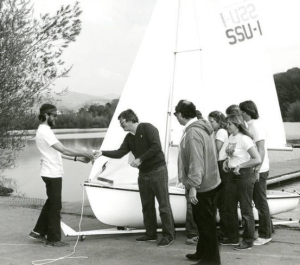
Naturally, Peter joined our team and soon after we unanimously voted him Captain, he managed to convince a local winery to sponsor the team and buy us a better boat. After that, we started winning. A lot. Peter’s aggression on the water intimidated me, but I marveled at his ability to capture even the slightest breeze and turn it into forward momentum—momentum that, more often that not, sailed us into first place.
III. TRADE WINDS
Doug and I broke up but we’ve held onto a deep, if intermittent, friendship. A couple years ago I submitted an essay I wrote about himan essay I wrote about him to Modern Love (rejected). As for Peter: he went on to win a hulls-worth of championships, including a silver medal in the 1988 Olympics and the 2007 America’s Cup. Like all the people in my life who made even a tiny impact, I never stopped thinking about Peter. I know he still lives on St. Thomas because I send him birthday emails every year (October 4), and usually get a quick “This is what I’m up to” message back.
Which is why, when Tracy moved there I thought, “Hey, I bet Peter would be happy to take Tracy sailing or maybe he could show her around St. Thomas!”
So I wrote him, asking if he, the coolest dude on the island, would consider inviting my “friend” Tracy on an outing.
He replied:
I would be happy to meet your fitness chick and give her an adventure with the coolest dude on the island!!! I don’t have a sailing biz or anything, but I have a cool little boat and could take her boating with us one day. I’m sure she’d love it.
And maybe you could do me a favor-
My sweetie just published her own book and is doing all she can to get it out there. Not to get rich, but to share her story and hopefully help the planet. Could I connect her to a rock star like you to help her with ideas, tips and advice?
“Shit,” I uttered.
Here I’d gone and dug myself a favor hole from which there was no escape. If I replied, “Sorry, Peter, but I don’t have the time to read, let alone help, your sweetie with her planet-helping book,” I knew I’d sound like a selfish jerk.
So I did what I normally do: I ignored the email, leaving Tracy to her solitary wanderings.
And me to my guilty conscious.
The next day I wrote Peter and told him I’d be happy to help said sweetie.
IV. YAWING
By way of email, Peter introduced me to his GF, Sharon Wallen, who introduced me to her book, HATCHED: How Nine Little Chicks Cracked My Shell. When I read the description of it online:
Imagine yourself in the midst of your busy, modern life. There you are - overwhelmed, perhaps even teetering on the edge of exhaustion - when your child asks to hatch a bunch of chicken eggs. Your blood pressure instantly skyrockets when you think of adding even one more thing to your list ... and a quick No falls from your lips.
But what sort of miracles might spring forth if you said Yes! instead?
I might have groaned a little. It sounded so…so…
. I could tell it was going to be a lot like the many (and I mean
) self-published memoirs I’d been asked to read, edit or write blurbs for over the years. Not that I hadn’t hit on some pockets of gold whilst traipsing through the memoir mines, but more often than not, navel-gazing autobiographers spend too much effort on recounting the past in all its semi-dull detail, and not enough time building enough tension and/or suspense to keep the pages flipping. Just because it’s a personal history, doesn’t mean it can’t read like a good novel
.
Regardless of my disinterest, I had to fulfill my side of the bargain. Right after I introduced Peter to Tracy, I wrote Sharon a long email glistening with ideas on how to promote her book. I sent her links to book marketing websites; went over social media strategies; critiqued her website; invited her to join a memoir group on Facebook. It wasn’t as if I was an expert—I’d done a crap job promoting my own memoir—but at least I could give her some immediate ideas.
Sharon wrote to thank me and attached a PDF of her book, adding that there was, of course, no pressure to read it.
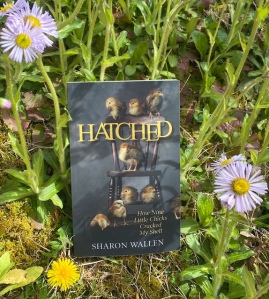
Well, I read it.
You know what? I loved it.
LOVED. IT.
And I believe it truly can help the planet. Or, at the very least, it helped me see why saying YES can open me up to magical thinking. To a life well-lived.
Here's the 5-star review I posted on Goodreads and Amazon:
You know the old saying, “Big things come in small packages”? It was exactly how I felt after reading the beautifully-written "Hatched: How Nine Little Chicks Cracked My Shell" by Sharon Wallen. Coming in at a bantam weight of only 145 pages, I devoured this memoir in a single sitting. It was that good. Wallen’s story begins when her young son asks if they can hatch some fertilized eggs from a farm they’d just visited. Like any harried wife and mother who is juggling a blended family, work, and a marriage that has run into trouble, her immediate reply is “no.” But then…then she begins to think about the person she used to be—the person who was open to the universe and its infinite possibilities. The person who used to say “yes.” So, she does. She brings home the eggs and a makeshift incubator. New lives break from those tiny shells, and with them, the perfect metaphor for what it meant for Wallen, herself, to break free from her own limited beliefs. Filled with humor, honesty and intelligence, Wallen has written a small but powerful story that is sure to resonate with anyone who needs reminding that “there are many ways to practice saying YES.” Indeed.
V. BERTH Tracy and Peter never did meet up, BUT, because of Tracy's yearning for solitude, I've begun what is destined to be a life-long friendship with a smart, beautiful, and inspiring human—a woman I happened to meet because she happened to be the new sweetie of a man who taught me how to harness the wind a million years ago and I happened to decide that he needed to befriend someone I hardly knew in the first place. Don’t you just love it when you think you're doing someone else a favor and you end up getting way more in return? Yeah, me too.
- Lisa Kusel

- Apr 29, 2022
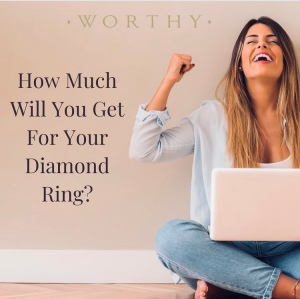
I.
For some time now I’ve been wanting to write an essay about losing my mom’s diamond ring soon after she died. I’d been the keeper of the “Kusel Diamond.” I was the person who was supposed to have kept it safe.
Only, I didn’t.
The more I thought about what went down the more I figured it would make for a pretty good story. But I wasn’t sure how to tell it. As I so often do, I asked my writer friend Margot (who has a creepy new YA thriller coming out this summer) for her advice. “Hey, I am trying to come up with an angle about how to write about my mom's diamond getting stolen,” I wrote her. “Like I don't want to just write about what happened.”
Margot suggested I think about why its disappearance was significant to me.
So, with her prompt loitering in the back of my head, I sat down to write my dark and curious tale. Here’s how the essay started out:
On Tuesday morning I was sitting at my desk casually reading the news when I panicked. It suddenly occurred to me that it was already midway through April, and I hadn’t yet gotten an email confirming that my safe deposit box had been automatically renewed for another year.
“They wouldn’t just cancel it and toss the stuff, would they?” I asked my husband, imagining some low-level bank clerk haphazardly tossing my mother’s jewelry into a plastic trash bin.
“Call them,” he said. “Or, better yet, why don’t you actually leave the house and walk up to the bank and talk to someone in person.” His snarky remark went un-replied-to. I knew he thought I’d become far too covanoid (adjective, 1. of, like, or experiencing paranoia about catching Covid), and had a hard time going out in public. I didn’t love being a shut-in, but yeah, I’d become one.
I called them.
Turned out my renewal wasn’t supposed to happen until May. I thanked the guy, sat back, and exhaled my relief. The few remaining pieces of my mother’s treasures were still snug as a bug in a rug in a slim metal box behind a thick iron door.
Sort of like the way I felt not going outside.
But then I flashed on the one thing that was missing from that box. The BIG ring. The ring I wrote about in an earlier blog post. The ring that my father wished he could steal back from his ex-wife, even if it meant cutting off her finger.
The ring that was going to be mine when she died.
II.
Anyone who’s been tagging along with me for the last few years (thank you, friends and followers) knows that my mother suffered from dementia. When I moved her into a memory care facility she insisted on taking her jewelry with her. Mind you, all the pieces she wore at the time were B-list baubles. A diamond “F” for Florine. A simple gold chain she wore around her neck. A few shiny rings purchased at TJ Maxx or Marshalls. The valuable stuff—the jewelry I’d surreptitiously absconded with before I moved her from California to Florida—was here in Vermont. Just up the street from where I live. In that safe deposit box. Number 169.
By the time she died from Covid-induced pneumonia in a $6000/month memory care center that didn’t have enough oxygen on hand, every single piece of jewelry she moved in with had somehow “disappeared.”
She passed, much to my shock and sadness, totally unadorned.
III.
At this point in the essay Margot’s prompt once again poked me on the shoulder. I was supposed to be talking about why the disappearance of my mother’s ring was significant and I’d only gotten as far as talking about her death and then, while remembering how all her costume jewelry got stolen in what was supposed to be a safe and nurturing environment, I got so worked up I had to stop writing and go for a walk.
IV.
With all that was happening in the world, and in my personal life, I honestly no longer cared that much about the ring. I didn’t care that my mother wanted it to be kept in the family; handed down from me to my daughter and then to her daughter, ad infinitum. That it was supposed to be forever known as the KUSEL DIAMOND. I knew I would never wear it. I knew Loy would never wear it.
My older brother suggested we slice it up into three separate diamond rings so that each of us could have “a piece of mom.”
I just wanted the money. Money I could use to travel to Australia or Patagonia, places I’d been bucket-listing for years.
When I saw this ad in the local paper
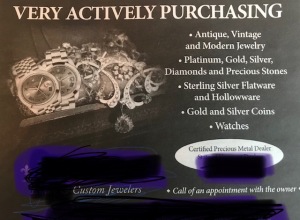
I acted on it. I phoned the store, told the owner what I had in my possession and made an appointment for the following week. When I showed up I was a bit put off that he wasn’t wearing a mask. Mind you, this was the summer of 2020, when the pandemic was in full throttle. I immediately disliked him.
Regardless. I was already there and he was deep into ooh-ing and aah-ing over my personal treasures, complimenting their exquisiteness, speculating over their value. After he compiled a list of all Mom’s watches and rings and pins and bracelets, he told me how much he’d pay me to buy them outright. When he got to the 8-carat diamond, he asked me what I thought it was worth.
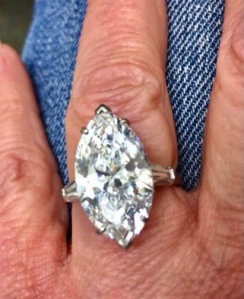
“I’m pretty sure my father said he paid $60,000 for it, but that was back in 1970. It’s got to be worth even more than that now,” I said, sounding like the desperate, adventure-deprived shut-in that I was.
He peered at me with pity in his eyes, as if I were but a silly child who thought money really did grow on old rings. “I doubt that very much,” he said with too much self-satisfaction. Then he asked one of his “experts” from the back room to come take a look. Said expert donned an eye magnifier, mumbled something, then looked up. “It’s got a lot of occlusions.”
The owner nodded knowingly. “I’ll give you $27,000 for it.”
I felt as if I’d been slapped. “What? No way.” I looked at the ring. Surely something that big and that shiny had to be worth more than $9000 a kid.
Sensing my cynicism, the man suggested that if I wanted to ascertain the ring’s true value, I should get it certified by the Gemological Institute of America (GIA). “If you want to do that, it’ll cost you $1250. I’ll send it out tomorrow. You’ll get it back in about a week.”
“Okay,” I said, wanting to get out of the shop as quickly as possible. “Go for it.”
Since he had to list something on the receipt, he put $60,000 in the space on the paper next to the diamond.
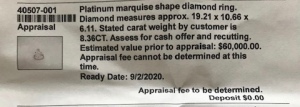
A week after I paid $1250 to the mask-less man to overnight the Kusel Diamond to the GIA in New York City, I received a phone call. Sounding as if he’d just stepped on a 6-inch cactus quill, the man in the jewelry store informed me that the diamond had been lost in transit.
Before I could faint from the shock, I collected myself and hit RECORD on my phone.
“What do you mean lost?”
He told me that the ring never arrived at the GIA and the address on the package had been changed. I had a few million more questions to ask, but at that point I was so distressed and angry I said I had to go and hung up.
The day after that call, the co-owner of the store (whom I never met), phoned me up and offered me $30,000 in compensation, “even though it's not worth more than $15k.”
When I apprised him of the fact that his colleague only days ago offered me $27,000, he postulated that it was because in their store they’d be able to sell it “for the bling factor. Someone who doesn't care about the GIA certification,” he said. I came right out and asked him what the store would have tried to sell it for. He said $35,000, to which I replied, “Then you should pay me $35,000,” to which he agreed.
Up to this point in time, no apologies had been tendered.
With both my hackles and suspicions raised, I let my brothers know the scoop. The younger one, a business owner who uses FedEx services on a daily basis, said he’d get one of “his guys” to look into it. Meanwhile, I fumed. I raged. I paced. I waited for more information to stream in.
A day later my brother’s guy sent us details of the FedEx tracking sheet:
Thursday , 9/03/202011:50 amNEW YORK, NYDelivered9:00 amNEW YORK, NYAt local FedEx facility9:00 amNEW YORK, NYAt local FedEx facility5:34 amNEWARK, NJArrived at FedEx location4:11 amINDIANAPOLIS, INDeparted FedEx locationWednesday , 9/02/202011:57 pmINDIANAPOLIS, INArrived at FedEx location10:50 pmDelivery option requestedHold at FedEx OnSite request received - Check back later for shipment status7:17 pmWILLISTON, VTLeft FedEx origin facility3:32 pmWILLISTON, VTPicked up9:46 am
As well as sharing his observations:
Never went on a delivery truck. Someone put through a hold at FedEx onsite at 10:50PM the day it was shipped. I assume it was done online. Not sure how they gamed the system. My understanding is that in FedEx Delivery Manager, only residential packages can be directed to be held at FedEx on-site locations. Not packages going to commercial locations. This certainly points to an inside job.
Furious, I was ready to drive to the store and hold the jeweler at gunpoint until he confessed his guilt. But that would have meant leaving the house, so instead I called him. He was, he claimed, completely innocent and as dumbfounded as I was. He, too, had done a thorough investigation and this is what he believed transpired:
Although he shipped the ring to the correct address (53 West 46th Street, Unit 500), it somehow got delivered to 530 Fifth Ave (which is a Walgreens two blocks away), where someone signed for it as “K GIA,” the intended recipient.
“Here’s the scam, Lisa,” he said. “Someone figured out that in that New York zip code, they carry GIA packages. They must have figured out that that driver had a GIA package and they pretended they were GIA. I heard from FedEx they carried New York State IDs. Two men approached the truck and they took the packages from the driver in front of 530 5th Avenue, which is a Walgreens.”
“Come again?” I could make neither heads nor tails out of this scenario. “Why did the driver go to the wrong address?”
“Sounds like it was a new driver, untrained, and he got approached by some guys who said do you have any GIA packages? Due to Covid we’re not really open. We’re picking up the GIA packages. Here’s our badge.”
“But it said it was signed for by the receptionist at the front desk of the GIA. Who did that signing?”
“I’m not sure. But their driver gave it to someone else. I get nervous with your questions.”
He gets nervous? I was still so confused, but no amount of prodding could clear it up. What it all came down to was this: the Kusel Diamond was gone.
He continued: “This is very upsetting for me as well….this is the first time in fifteen years I’ve actually lost a package…I can make it whole by paying what I put on the receipt and that’s going to be a hardship for me. The reality is that stone is worth less than $60,000…but I put $60,000 because that was the declared value when you came in. But it’s not worth that….it’s a fifteen to $20,000 stone…however, I don’t want any problems. I want to protect my reputation, but I will pay what was on the receipt.”
A hardship for him? That made no sense. “Won’t FedEx also pay you the $60,000 back?” I asked, knowing full well they would.
The answer to that question was answered through his lawyer, who by now, was drawing up the terms of the payment:
There is no FedEx claim. We elected to get coverage from our insurance company. We are covered for $70K for this loss and will pay you out $61,250 ($60K which Lisa declared as the value + $1250 GIA cert fee).
So, um, no hardship. For him, that is.
For me, it became a psychological and familial hornet’s nest. Neither brother wanted to settle. They wanted to SUE FedEx, the store, the jeweler, and anyone who had ever said a bad word about our mother. They didn’t think the $60,000 offer was enough. They consulted lawyers. Assuming it’d already been sold down some shady back alley, they scoured the internet auction sites, searching for the diamond (okay, so I was guilty of doing this, too).
I got tired of feeling angry. I accepted the terms, which included, among other things, signing a non-disclosure agreement (NDA). I was not allowed to ever defame the proprietor or his business by writing about him. I was not allowed to mention his name. Ever.
I drove to the store, grabbed the check (which was made out to my husband because the trust was in his name),
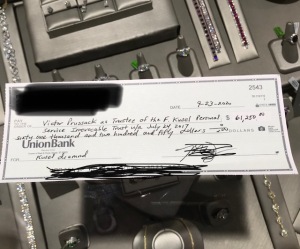
wired my brothers $20,000 each, and moved on.
V. (Where I return to the ever-illusive prompt)
Except, I haven’t. Not entirely. It’s been almost two years since the crime took place and I’ve yet to find peace. Maybe because I don’t entirely understand how what they say happened actually happened. (What kind of driver would EVER just hand over a package to two guys claiming to be who they obviously weren’t? And who CHANGED the form the night it was shipped?)
I feel as if, somehow, when the bad people stole the ring, they also stole a piece of my mother. I know, I know: I’d planned to sell it anyway, but having it appropriated without my permission, by nefarious (and possibly sleazy insider) means, has left an ugly stain on the memory of my mother wearing that ring at my brothers’ bar mitzvahs, my graduations, my wedding—all those special occasions that called for her to drive to the bank. There, she would open her safe deposit box, slip the ring onto her finger, then twist the diamond to the inside of her hand so as to conceal it from would-be robbers.
She’d keep it like that, the sharp tips of the marquis pressing into the soft fleshy parts of her ring finger and left palm, through the entire car ride or plane trip to wherever it was she was traveling; hiding it; keeping it safe; until the moment of the big event; when she would turn it upright for all the world to see.
When she would, at last, let it catch the light.
- Lisa Kusel

- Dec 15, 2021

Last week a friend of mine who has a memoir coming out emailed me to ask if I could introduce her to Lauren Hunter (not her real name), the Books Editor at _____Magazine. Realizing what my friend had in mind, I was quick to cut her off at the pass: convincing Lauren Hunter to read a book written by anyone but a star author, I warned, was akin to convincing MAGA fans to wear face masks.
Autumn 2001
A few days after my agent sent out my book of interrelated short stories to a dozen or so NYC editors he called to say that
Lauren Hunter, a much venerated editor at at top publishing company, wanted to chat with me in person. “What does she want to know?” I asked nervously. “She probably wants to learn a little more about you as a writer. What she can expect from working with you, that sort of thing,” he replied in soothing tones. “Don’t be nervous, Lisa,” he said to the pregnant woman pacing the floor. The next morning, just as I was about to pass out from hyperventilating, Lauren phoned. I’d spent the entire sleepless night rehearsing. I’d tell her how I’d been penning fiction since I was a tyke; that it was my dream to be a novelist; that I would be open to any changes she had in mind; that I already had an idea for another book; and that I was a really fast writer. All but the last statement were true. “Hello, this is Lisa,” I said in a deep steady voice, hoping I’d sound smart and stable; not jumpy and nauseated (which was exactly how I felt). Irrationally, I worried that through the miles of phone line Lauren would be able to see that I was wearing red flannel pajama bottoms and a threadbare oversized Sonoma State University sweatshirt. That somehow she’d know I was the last person on the planet whose photo belonged on the back cover of a book. “Hi Lisa. This is Lauren Hunter.” “Thanks for calling.” I replied as I rubbed my four-months-along belly. I so didn’t want my growing baby to feel my tension. “I wanted to chat a little about
, your wonderful book.” And then, before I could launch into my spiel; before I could prove my authorial worthiness, she began listing off all the reasons why I should choose
over all the other editors on the planet.
Spring 2004
When, during a phone conversation I stupidly mentioned to Lauren that I would be in NYC to visit my husband’s parents, she suggested we get together for lunch to discuss “some things.” I honestly didn’t want to. We’d met in person, briefly, twice before and she was not of the warm-and-fuzzy ilk. Throughout our time working on my first book together she came off as a detached, distant editor. It was her assigned role, after all. She was the demanding wrangler of my creative gurgitations. The critical gatekeeper who held the keys to my would-be writing career. She terrified me. We agreed to meet at Café Lalo,

the same place where Tom Hanks met Meg Ryan in “You’ve Got Mail.” I made sure I was the first to arrive so I could find a table and not have to do that awkward pre-sit-dance—you know the one I’m talking about: it’s when you and the person you’re meeting have to stand in front of the hostess and you shuffle your feet and put your hands in your pocket or mindlessly flap the notebook you’re holding up and down in idiotic waves while the blonde babe behind the podium scans the room looking for a vacant spot and you have no idea if the vacuous small talk about the weather or the crowded subways is making you sound like a moron. Anyway, I got there in plenty of time to avoid
and was shown to a two-top at the back of the place. Instinctively, I knew Lauren would want to sit facing the restaurant. She’d want to have the commanding view of the café’s comings and goings. She would be want to see and be seen. So, duh, I sat facing the brick wall, and, because I had no idea if she’d recognize me by the back of my head, I had to stay twisted around—my hands on the top of the curved slightly splintery wooden chair—so I could catch her when she walked in. I stayed like that—my upper body curled uncomfortably backwards—for some ten anxious minutes. When she finally breezed in and removed a pair of fashionable sunglasses from her fashionable face, I waved at her like an excited school kid who sees her mom waiting at the bus stop after a particularly hard day of kindergarten. She glided over, saying, “Excuse me,” to the people at the table next to ours after accidentally bumping it while squeezing her way into the slim space between us. Before we even exchanged a word, a perky waitress appeared. “Are you ready to order?” Lauren picked up the menu I’d arranged on the table, gave it a quick glance, and said, “I’ll have the egg salad and a coffee.” When the waitress looked at me I hesitated. I’d already read the menu three times and had become so overwhelmed with nervousness and nausea, that I’d lost my appetite. (Yes, I was a published author in her thirties; yet I still suffered mightily from Imposter Syndrome. Part of me actually believed Lauren had invited me to lunch to fire me.) Which she did, sort of. But, I’m getting ahead of myself. “I’m good with just coffee,” I said to the waitress, apologetically. “So, let’s talk about
,” Lauren said a heartbeat after the waitress left. “It’s good, but it still needs a lot of work.” I’d like to be able to tell you what happened after that, but because of the egg salad, I remember little of the remainder of that lunch date. What I
remember is the waitress placing a huge plate of food in front of Lauren. On it sat an enormous heap of creamy yellow egg salad. Next to it were two slices of perfectly-toasted bread, some paper-thin circles of red onion, and a couple of thick rounds of red juicy tomatoes. One glance at Lauren’s food and suddenly I was famished. Abandoned-dog-on-the-street-starved. As I watched her daintily convey the onions to the outskirts of her plate
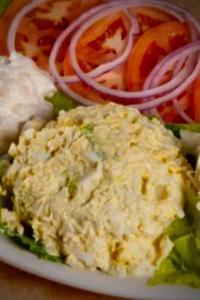
before taking three tiny bites of the egg salad and then putting down her fork, my stomach growled and my mouth watered. I wanted nothing more in life than for her to offer me a bite. To say, “I’m done. Do you want the rest?” Because, yeah, I would have eaten the rest. It was all I could do to keep from reaching across the tiny expanse of table, grabbing a piece of bread and slathering it with that green-herb-flecked egg salad. The salad she was clearly NOT EATING. She continued to talk about the faults in my plotline while I stared incredulously. Was she really going to leave all that delicious food
. Who does that?
When the waitress reappeared to fill our coffee mugs, Lauren stated, “I’m finished. You can take it,” with me dying a slow deprived death across from her.
Only when the sweet smell of the neglected egg salad had finally drifted away was I able to concentrate on what she was saying and what she was saying was something along the lines of, “…and so I won’t be your editor anymore, but I know you’ll be in good hands with whomever they assign you to…” Lauren was letting me know that she was going to work for another publisher.
Winter 2018
Not surprisingly, Lauren and I lost touch. For a few years after we parted ways we exchanged short semi-personal emails catching one another up. After those ended I occasionally bumped into her on Facebook and Twitter—liking this; commenting about that—but eventually our relationship, like Borders bookstores, closed for good. Then one morning, while sitting in my dentist’s office waiting room, I started flipping around an old issue of
when suddenly I saw her name. I already knew that after Lauren handed me off to an editor who’d hated my writing, she edited a nonfiction book that became a worldwide bestseller.

And, that, following a few more stints in the publishing world, she became the Books Editor for a popular women's magazine. But, for some reason,
her name next to a book review in a magazine I’d never actually read was startling. I looked over at another woman in the waiting room and tried catching her eye. I desperately wanted to say, “See this person? She edited my first book!” with my index finger stuck defiantly next to the printed words: LAUREN HUNTER. I was aglow with misconceived pride. Ridiculous though it was, I felt as if this vicariously made me a member of the all-star literary world. By the time my clean teeth and I arrived back home I’d decided that Lauren
me. After all, she’d jilted me for, for, what—a VIP with an important point to make? She’d dumped me and my words onto the desk of an editor who didn’t “buy that Peter would ever leave his wife for Mona.” Plus, she’d hadn’t offered me even one bite of that egg salad. The least she could do, the frenzied voice in my head argued, was REVIEW MY BOOK. I emailed her an incredibly polite, humble and slightly beggy note asking if she’d, ah, be willing to read
my new memoir, which was “really funny and had gotten some terrific reviews.” I closed out the letter reminding her who I was, just in case. I assumed I wouldn’t hear back from her. I wasn’t a bestselling writer or a celebrity or even a person of minor interest. I assumed correctly. I told my friend that yes, I knew Lauren way back when, and if I could get her book reviewed, I would. But I had no pull with Lauren, I regretfully informed her. I had some back in 2001 when she thought I was the next “it” girl author. I had even less in 2004, when I coveted that egg salad on her plate. Now, what little connection we’d had was long gone. After typing “Sorry. Good luck,” I hit SEND and then sat back and stared out my window toward Lake Champlain, watching the small whitecaps bouncing over the breakwater in the distance. Okay, it was a bummer she didn’t write me, but it was still pretty gratifying to know that
Lauren Hunter had been my first-ever editor. She had thought I was so talented that she'd convinced her bosses to pay me a lot of money for my words. She had ushered me into the next phase of my life. She’d pushed me to be a better writer. She’d made my childhood dreams come true. If anyone owed anyone anything, I owed
. If ever we were to meet again for lunch, I’d still give her the seat not facing the back wall. Only this time I’d order my own plate of food. And I would be sure to offer her a bite.































































































